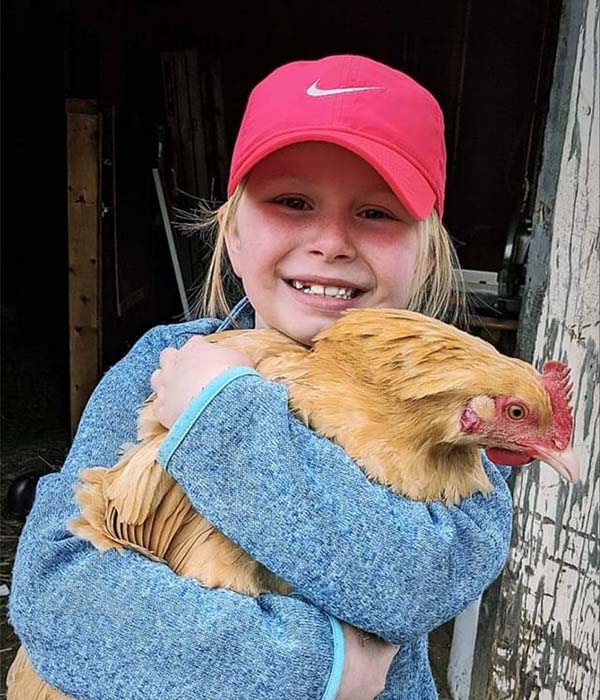
Raising backyard chickens can be a fun experience for the whole family! With chickens’ adorable antics and unique personalities, children are inherently drawn to them. Around the farm, children can be responsible for their flock and feel a sense of pride and ownership. Younger children can help to fill the feeders, gather eggs, and round up the chickens in the evenings. Older children can assist with cleaning the coops, letting the chickens out each morning, and filling the waterers.
Additionally, kids can teach chickens to come when called (with the help of dried mealworms), learn about the joys of gardening with chickens, and even bring their favorite chicken on a tour of the neighborhood using the Valhoma Chicken Harness. We have even heard of some young chicken enthusiasts teaching their birds tricks and we have watched some incredible videos of chicken agility on social media!
Any way you look at it, a small flock of friendly chickens can be a fun addition to your farm, especially when you have kids in the mix. Keep reading to learn more about some of the friendly and calm chicken breeds that are excellent choices for raising when you have young farmers involved.
Buff Orpingtons

Often referred to as “Golden Retrievers of the Chicken World,” Buff Orpingtons are one of the most popular breeds of chickens for poultry farmers of all ages. These beautiful golden-colored dual-purpose birds respond extremely well to attention and generally enjoy being handled. The breed tends to be non-aggressive, which makes them an excellent choice for families. Many children use Buff Orpingtons as their 4-H and/or FFA poultry projects.
Additionally, Buff Orpingtons are very laid-back birds that are able to handle both free-range and enclosed environments. They tend to be quite quiet as well, making them a popular choice for neighborhoods or homesteaders with a limited amount of space. As a heritage breed, they are inclined to be healthy, hardy, and cold-tolerant. You can expect a hen to lay 200-280 large brown eggs each year.
Lavender Orpingtons
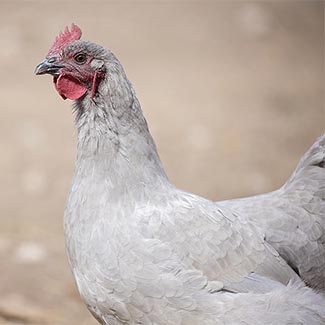
Possessing many of the great qualities of their Buff Orpington relatives, Lavender Orpingtons feature a gorgeous silver-purple coloring. These friendly birds love attention and have been known to jump on laps and come when called when they are raised from chicks. This breed is exceptionally docile while also being extremely beautiful. They are popular for beginner chicken keepers as well as families with young children.
Similar to their Buff counterparts, they are agreeable to nearly any living condition and tend to do well in small spaces. They are also quite quiet and are not apt to fly much, making them a great choice for neighborhoods and a wonderful urban chicken. A Lavender Orpington hen averages 250 eggs per year.
Australorps
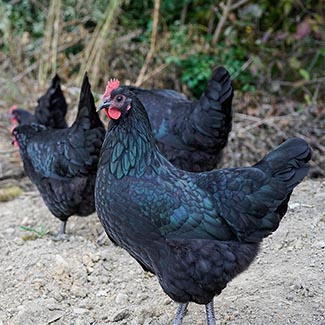
An Australian cousin of the Buff Orpington and Lavender Orpington (are we sensing a trend here?), the Australorp is a large, docile, black chicken breed. They are excellent mothers, making them a great choice if you want to raise a flock with your children. Typically, the Australorp is a black bird, but when the sun hits them, they have an amazing beetle-green sheen… they are stunning birds.
The Australorps are very popular as 4-H and FFA projects because they have such sweet temperaments for dual-purpose birds; they can commonly be seen competing at country fairs. Notoriously calm and friendly, the Australorp does well in a mixed flock or a single breed flock. They are highly productive egg layers, with hens averaging 300 brown eggs a year.
Ameraucanas
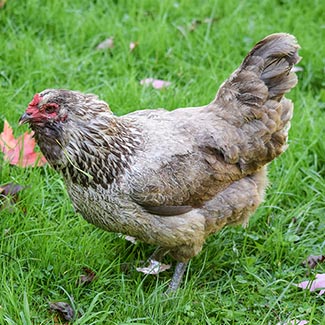
Ameraucana chickens, also referred to as Easter Eggers, make an exciting addition to any child’s flock. These non-aggressive birds do best if handled by children from the chick on to the adult stage. It is important that they are handled early in life, otherwise, they can be shy and a little flighty. They are known for building strong bonds with their humans
Easter Eggers are excellent foragers and can provide backyard tick control. They are mainly prized for their beautiful-colored light blue, seafoam green, and pink eggs. Children will love running to the nesting box and seeing the treasures that have been left for them by these fabulous layers. You can expect up to 280 extra-large eggs each year. They can also tolerate a wide range of temperatures, making them ideal for the New England climate.
Barred Plymouth Rocks

Showcasing unique black and white stripes that help them to stand out in a flock, Barred Plymouth Rocks are well known for their gentle personalities. These chickens are one of America’s oldest breeds, first appearing in the mid-1800s. They are known to be friendly, sweet, and docile birds. These beautiful birds have even been nicknamed “America’s Favorite Breed!”With a relaxed and unfussy demeanor, they are happy in confinement with sufficient space, however, they also make great foragers when allowed to free-range.
Hens are not particularly broody but will hatch young if allowed and make great mothers. Roosters also tend to be docile and protect the flock. Barred Plymouth Rocks tend to be quite smart, picking up routines quickly. Many homesteaders choose them because they are active and silly, yet still thrive on human attention. They are also consistent layers, continuing to lay through the winter months and laying up to 200 medium/large eggs per year.
Silkie Bantams

This miniature ornamental chicken breed is extremely popular, largely due to their impressive feathering, but also because of their docile nature. They can be a third to a fifth of the size of a standard chicken. They love sitting in laps and their soft plumage feels like you are petting a cloud. Their feathering feels more like goose down than a traditional chicken feather. They come in colors of white, black, gray, buff, and more. They have great personalities and children are enthralled by their adorable antics.
These petite birds are cold and heat hearty, making them a great choice for beginner chicken keepers. Silkie Bantams tend to enjoy confinement and small runs. They are not known for their egg-laying production, but they can be expected to lay about 100 small eggs per year.
Faverolles

Sweet and adorable, Faverolles is a French breed. They have feathered feet, five toes, a beard, and puffy cheeks, all of which make them highly endearing to children. Faverolles have a tendency to be a bit shy, but they are also very mild-mannered. If they are raised from chicks and handled often, they will become wonderful pets that thrive on attention. Many Faverolles owners report them to be cuddly and comical and can be especially lovable in a one-on-one setting.
The petite Faverolles tend to be low on the pecking order and do not do well in mixed-breed flocks, especially if you have aggressive birds. They are hardy in the winter and do very well in the chilly New England temperatures. Prolific egg layers, a Faverolle hen will lay about 240 eggs per year.
Cochins
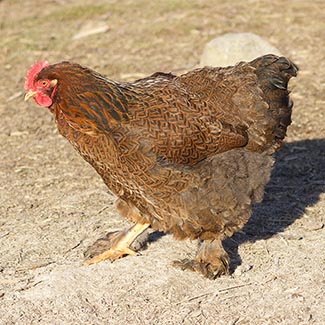
Very large yet very docile, the Cochin is a gentle giant. They are very relaxed and are easily tamed. The Cochin is laid back and prefers to be fed over scavenging for food, for this reason, they are not well suited for free-ranging. However, they are easily kept in captivity and do not have the desire to wander.
Many children are drawn to their impressive feathering and beautiful coloring, particularly their feathered feet… they truly look as though they are wearing slippers! Cochins have a very calm disposition and are rarely aggressive (even the roosters!). They do tend to be broody, so many poultry owners use them when hatching chicks. They lay only about 150 eggs per year, but production tends to be steady throughout the year and into the winter. Because they are larger than some other breeds of chickens, it is important to build your coop appropriately for their size.
Brahma Chickens
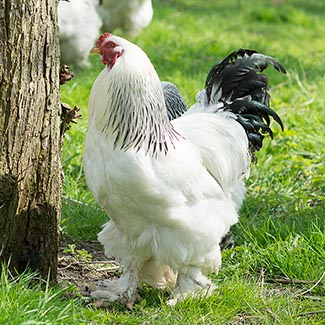
Featuring feathered feet, these unique-looking chickens look like they are wearing slippers! Large and docile, many chicken keepers find that their Brahmas are extremely friendly toward people. They can measure up to 30” tall, which makes them the biggest chickens in many flocks. They have a calm demeanor and tend to be peaceful with other birds. Due to their extreme size, you will want to ensure that you have a large enough coop before bringing Brahma chicks home.
Brahmas are great winter layers, unlike many other breeds of chickens. They tend to ramp up egg production in the months of October-March. This makes them a welcome addition to any flock, helping you maintain your egg production throughout the year. They can be expected to lay about 150 eggs per year.
Polish Chickens

Every time you look at these chickens, they are sure to bring a smile to your face. The feathered plumage on the Polish Chickens’ heads looks as though they have a full head of hair. Considered an ornamental breed, they often have quirky personalities that match their fabulous hairdos.
These entertaining chickens are active, yet are very friendly toward people. Young children are drawn to their unique looks, and, fortunately, most members of the breed tolerate being picked up, carried, and snuggled. They have a very inquisitive nature and love to get into everything. While not known as a laying breed, you can still expect them to lay up to 120 eggs per year.
In the cold winter months, Polish Chickens require special attention. They MUST be in a dry location, otherwise, their feathered heads can become frosty or even freeze.
Wyandottes
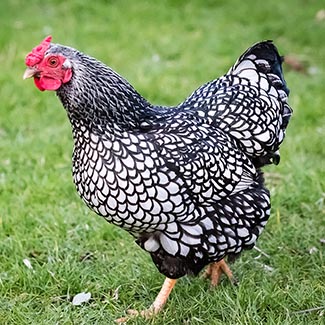
With their easygoing nature and beautiful feathering, Wyandottes are a favorite among many backyard farmers. They tend to be very cold hardy and heat tolerant, taking their environment in stride. Wyandottes are generally accepting of love and attention, often reciprocating if they are well-socialized from an early age. Typically the breed is docile and non-aggressive, making them an excellent choice for children.
If you plan to hatch chicks, these hens make terrific mothers and care for their brood. We love hearing our young customers talk about the joys of raising their flock from eggs… it is such an incredible learning experience for aspiring poultry farmers. Wyandottes are also dependable layers, laying up to 260 eggs per year.
While the breeds of the chickens are important, their temperament will have more to do with how your chicks are raised. The best way to ensure child-friendly chickens is to purchase chicks when they are young and handle them as frequently as possible. By familiarizing your chicks with humans from an early age, you will quickly be welcomed as a member of their flock.
Introducing chickens into your farm is fun for all members of the family! From teaching your kids about responsibility to giving them hours of enjoyment, chickens are a wonderful way to encourage your kids to spend more time outside enjoying the great outdoors. With a bit of planning and careful supervision, children and chickens truly are a wonderful match.
Would you like to learn more about the chicken breeds available at The Cheshire Horse? We encourage you to read our blog posts about Layer Chicken Breeds, Dual Purpose Breeds, Fancy Chicken Breeds, Bantam Chicken Breeds, Turkeys and Guinea Fowl, and Waterfowl.
